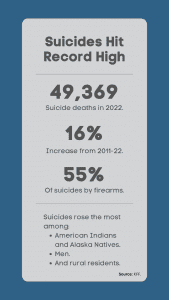In the two years before the pandemic, suicides in the United States started to fall. But 2020 saw the nation’s suicide rate tick back up, hitting a record high in 2022, according to the latest data from KFF.
Now, new research has uncovered an unsettling link between visual impairment and elevated suicide risk. This comprehensive review and meta-analysis examined data from more than 30 existing studies involving nearly 5.7 million participants. It revealed those with visual impairment are at a higher risk of suicidal thoughts, behaviors, and deaths.
Earlier studies – such as this 2016 paper that appeared in The Lancet – have hinted at this link, but this project sought to “consolidate the available literature on the association between visual impairment and diverse aspects of suicide, with the intention of illuminating both the extent of this association and the potential risk factors.”
Specifically, the researchers found that the odds of suicidal behavior in individuals with visual impairment were nearly two-and-a-half times higher than those without any such impairment. Similarly, the researchers found that the risk of suicidal ideation was about twice as high while the risk of suicide death was 1.89 times higher.
Methodology
The paper, published by the American Medical Association, covered a broad swath of populations and showed that adolescents appear to be the most vulnerable, which isn’t necessarily surprising since suicide rates have climbed the fastest among younger Americans – along with people of color, and rural residents. 
“These findings underscore the critical need to address mental health issues among individuals with visual impairments, especially adolescents,” the study’s authors wrote. “Visual impairment can significantly impact quality of life, leading to social isolation, depression, and decreased independence, all of which are known risk factors for suicide.”
The researchers conducted an exhaustive search of multiple medical databases, including PubMed, EMBASE, Scopus, and the Cochrane Library.
Age Remains a Suicide Risk Factor
The analysis revealed that age is a significant factor in the risk of suicide among those with visual impairment, with adolescents facing the highest risk. The researchers blame the unique challenges of navigating adolescence with a visual impairment.
“Adolescence is a critical period of development, and the added burden of visual impairment can exacerbate feelings of isolation and hopelessness,” the authors explained. “It is essential for healthcare providers, educators, and families to be aware of these risks and to provide the necessary support and resources.”
The authors of the study concluded by issuing a call for boosting awareness and employing more targeted interventions to help mitigate the suicide risk in this vulnerable population. They also stressed the importance of more research to evaluate the underlying mechanisms and develop more effective prevention strategies.
The study results serve as an important reminder of the broader impacts of visual impairment on mental well-being. It also highlights how critical comprehensive support systems are to protect those at risk.
Further Reading
Mental Health Issues Threaten Maternal Mortality Numbers
New Study Reinforces PCOS-Suicide Connection
VA Fights Its Own History With Early Success of Suicide Prevention Program




